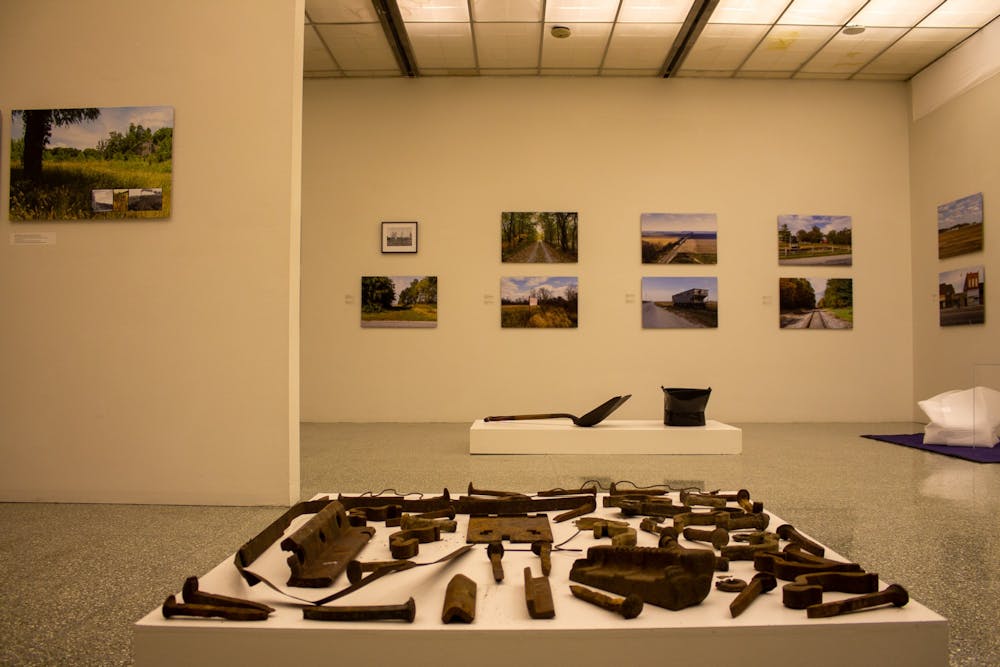The Monon Railroad was once one of the staples of Indiana, linking towns and cities from Lake Michigan to the Ohio River. Most of the railway system has been abandoned or repurposed, but its history provides insight into Hoosier communities.
The Monon Railroad, once known as the “Hoosier Lifeline,” is one of the focuses of the Grunwald Gallery’s upcoming exhibition, “Hoosier Lifelines: Environmental and Social Change Along the Monon, 1847-2020.” Running from Feb. 9 to March 12, the exhibition will feature a collection of photographs and artifacts from three artists used to capture and explore the Monon’s history and contributions to Indiana.
The art featured in the gallery will consider the rise of the timber and limestone industries, shifting methods of energy production, how the development of the Monon did not equally benefit all and more. The exhibition is a collaboration between the Environmental Resilience Institute at IU and the Grunwald Gallery and was funded by the “Prepared for Environmental Change” grant.
The Environmental Resilience Institute was developed in 2017 as part of IU's Grand Challenges Program, an initiative that involves collaboration between researchers and community members of varying backgrounds in order to combat issues facing the public. In the case of the ERI, one of the major issues would be climate and environmental change are some of the major issues the institute seeks to address.
The exhibition will also reflect on human-induced changes that are responsible for Indiana’s changing climate in the current age, the Anthropocene, according to the Grunwald Gallery.
Eric Sandweiss, a professor of history and member of IU’s Environmental Resilience Institute, helped develop the exhibition’s theme.
Related: [IU's Grunwald Gallery exhibits pieces from Indiana's prehistoric past]
Sandweiss and ERI fellow Elizabeth Grennan Browning collaborated on developing the theme and providing historical interpretation for the exhibition: that the now unused Monon Railroad line opens a window into the history of Hoosiers’ interactions with their changing environment.
“The Monon once helped to join Indiana towns and cities from Lake Michigan to the Ohio River,” Sandweiss said. “Today, as our artists revisit those same places, we see the need of finding a new way to connect, a new way to make communities, a new way to draw on the abundance of the earth.”
Though the Monon brought prosperity and resources to Indiana, Sandweiss said there are drawbacks to development and the exploitation of natural resources.
“We now know that our historical success has come with a steep price: not only are we depleting the finite resources on which we depend for our way of life, but we are also altering the planet as we do so,” Sandweiss said.
Maria Whiteman, visiting fellow and artist at the ERI, is one of the artists for the “Hoosier Lifelines” exhibition. Her goal is to use art as a way to connect viewers to the natural world, she said.
“It’s important to me as an artist to create a visual language to understand these intersections of the human-natural world in order to help us think of the future in full awareness, and of the actual character of the physical and mental landscapes we currently inhabit,” Whiteman said.
Whiteman’s work at the ERI began with studying mushrooms and other fungi that are predominant features of the local landscape. This brought her to investigate the role of fungi in many ways, including their impact on ecosystems and their nutritional and medicinal uses. Whiteman said these interrelationships underlie environmental science and history, and this approach allows her to create visual entry points for people to approach the art through a visceral, emotional experience.
This project illuminated changes in Indiana for Whiteman, the most striking of which being Indiana’s culture of monocropping, an agricultural process by which the same crop is grown in the same plot year after year. Indiana’s vast stretches of deciduous forests have become smothered by fields of corn and soy according to Whiteman.
Whiteman worked with artists Betsy Stirratt and Richard Koenig on the exhibition, and Stirratt has the additional perspective of being the founding director of the Grunwald Gallery of Art. As the director of the gallery, Stirratt determines which exhibits the gallery will feature.
Stirratt said the history-based “Hoosier Lifelines” expresses something that has happened all over the country. Railway infrastructure was once a vital part of both the economy and connection between people.
“People relied on the rail,” Stirrat said. “This brings to light the environmental changes that have happened since that time — how those changes have taken place and how we can hopefully adapt to those changes. It’s really about where we’ve come from and where we’re going to go.”






